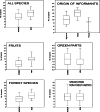Wild Edible Plants Used by the Polish Community in Misiones, Argentina
- PMID: 26691861
- PMCID: PMC4673098
- DOI: 10.1007/s10745-015-9790-9
Wild Edible Plants Used by the Polish Community in Misiones, Argentina
Abstract
We studied the cultural significance of wild edible plants for Eastern European migrants who settled in rural subtropical areas of South America. In 50 interviews with Polish migrants and their descendants in northern Misiones, Argentina, we recorded the use of 41 botanical species and two mushroom taxa. Different cultural significance indices were applied and sociodemographic factors such as gender, age and origin were addressed. Out of the ten most salient species, nine were fruits (Eugenia uniflora, Eugenia involucrata, Rollinia salicifolia, Campomanesia xanthocarpa, Syagrus romanzoffiana, Allophylus edulis, Plinia peruviana, Plinia rivularis, Eugenia pyriformis) and only one was a green vegetable (Hypochaeris chillensis). None of our informants reported famine foods, recreational teas or condiments. Men mentioned more wild edible species than women due to their more extensive knowledge of the forest plants growing further from settlements.
Keywords: Argentina; Atlantic Forest; Cross-cultural ethnobotany; Cultural significance indices; Polish migrants; Wild food plants.
Figures



Similar articles
-
Phytotherapy of Polish migrants in Misiones, Argentina: legacy and acquired plant species.J Ethnopharmacol. 2014 May 14;153(3):810-30. doi: 10.1016/j.jep.2014.03.044. Epub 2014 Mar 28. J Ethnopharmacol. 2014. PMID: 24680991
-
Plants used as food and medicine by Polish migrants in Misiones, Argentina.Ecol Food Nutr. 2015;54(3):255-79. doi: 10.1080/03670244.2014.983498. Epub 2015 Jan 20. Ecol Food Nutr. 2015. PMID: 25602720
-
Forms of medical pluralism among the Polish Community in Misiones, Argentina.Anthropol Med. 2016 Aug;23(2):205-19. doi: 10.1080/13648470.2016.1180580. Epub 2016 Jun 30. Anthropol Med. 2016. PMID: 27362357
-
Wild vascular plants gathered for consumption in the Polish countryside: a review.J Ethnobiol Ethnomed. 2007 Apr 15;3:17. doi: 10.1186/1746-4269-3-17. J Ethnobiol Ethnomed. 2007. PMID: 17433114 Free PMC article. Review.
-
An ethnobotanical perspective on traditional fermented plant foods and beverages in Eastern Europe.J Ethnopharmacol. 2015 Jul 21;170:284-96. doi: 10.1016/j.jep.2015.05.018. Epub 2015 May 15. J Ethnopharmacol. 2015. PMID: 25985766 Review.
Cited by
-
Foods from the wild: Local knowledge, use pattern and distribution in Western Nepal.PLoS One. 2021 Oct 21;16(10):e0258905. doi: 10.1371/journal.pone.0258905. eCollection 2021. PLoS One. 2021. PMID: 34673823 Free PMC article.
-
Ethnobotanical study of wild edible fruits in eastern Bhutan.J Ethnobiol Ethnomed. 2022 Mar 30;18(1):27. doi: 10.1186/s13002-022-00526-8. J Ethnobiol Ethnomed. 2022. PMID: 35354474 Free PMC article.
-
Gathered Wild Food Plants among Diverse Religious Groups in Jhelum District, Punjab, Pakistan.Foods. 2021 Mar 11;10(3):594. doi: 10.3390/foods10030594. Foods. 2021. PMID: 33799901 Free PMC article.
-
The role of ethnic tourism in the food knowledge tradition of Tyrolean migrants in Treze Tílias, SC, Brazil.J Ethnobiol Ethnomed. 2018 Apr 6;14(1):26. doi: 10.1186/s13002-018-0224-9. J Ethnobiol Ethnomed. 2018. PMID: 29625616 Free PMC article.
-
Wild Plants Used as Herbs and Spices in Italy: An Ethnobotanical Review.Plants (Basel). 2021 Mar 16;10(3):563. doi: 10.3390/plants10030563. Plants (Basel). 2021. PMID: 33809800 Free PMC article. Review.
References
-
- Aguilar S, Condit R. Use of Native Tree Species by an Hispanic Community in Panama. Economic Botany. 2001;55(2):223–235. doi: 10.1007/BF02864560. - DOI
-
- Arenas P, Scarpa GF. Edible Wild Plants of the Chorote Indians, Gran Chaco, Argentina. Botanical Journal of the Linnean Society. 2007;153:73–85. doi: 10.1111/j.1095-8339.2007.00576.x. - DOI
-
- Arias Toledo B, Galetto L, Colantonio S. Uso de Plantas Medicinales y Alimenticias Según Características Socioculturales en Villa Los Aromos (Córdoba, Argentina) Kurtziana. 2007;33(1):79–88.
-
- Bartolomé LJ. Colonias y Colonizadores en Misiones. Instituto de Investigación Facultad de Humanidades y Ciencias Sociales. Posadas: Universidad Nacional de Misiones; 1982.
LinkOut - more resources
Full Text Sources
Other Literature Sources
